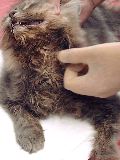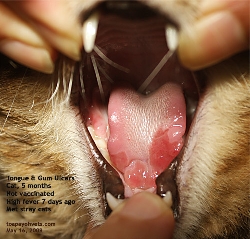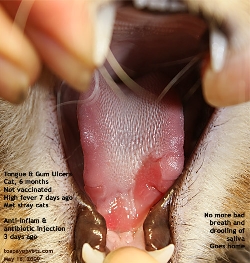Case written: 21 Jan 2001
Case updated:
12 March, 2015
An adolescent cat with the most stinking stench of bad breath was brought into the
veterinary clinic.
" Young cats don't usually have halitosis," mumbled Nurse Ann. This
cat perfused the air with an
overpowering bad smell. She had experienced all sorts of necrotic rotting smells in her
five years at the veterinary clinic. And she thought she had experienced all.
Young cats don't usually have halitosis," mumbled Nurse Ann. This
cat perfused the air with an
overpowering bad smell. She had experienced all sorts of necrotic rotting smells in her
five years at the veterinary clinic. And she thought she had experienced all.
Saliva was drooling from the mouth. A very sticky coat glued onto the matted
hairs of the neck and the front legs. "It looked like the cat has ingested something poisonous," continued Nurse
Ann as she registered the case.
Groomer Ken had a look. "Looks like the cat had
been bitten by a rat, Mrs Lam," he said, "there's two small bleeding ulcers on
the upper lips, near the canine teeth. She's got rodent ulcer"
"You mean that the rat bit the cat causing ulceration in the upper lip?' asked Mrs
Lam who had brought in the cat. Mrs Lam was not surprised as this was a stray cat
and there were a few big rats seen at the hawker stalls in the wet market of
Sembawang.
Where's there food or exposed garbage, there's rats. A rodent ulcer in the cat. This was
the first time she knew about this. Groomer Ken looked serious and nodded his head.
"Rodent ulcers are not caused by rat bites, Mrs Lam," I said to
Mrs Lam after she had settled down in the consultation room, "they are slow healing ulcers, sometimes called
indolent ulcers. The cat requires a lot of nursing care."
Slow healing meant a long period of veterinary treatment and of course, a higher
veterinary bill. Mrs Lam was worried about the costs. "She's only a stray
cat," said Mrs Lam. "Please lower your veterinary fees."
Every time she would bring in a stray cat and she would say the same about
the high veterinary fees in Singapore's private veterinary clinics compared
to the government clinic at Kampong Java Road. Actually, the fees were
as low as could be if the private clinics did not want to lose out to the
large subsidised government "Animal Infirmary" which was doing a roaring
business.
"There are two small upper lip ulcers," I confirmed. "It is possible that
the cat is suffering from the Eosinophilic Granuloma Complex. There are three
separate skin conditions making up the Eosinophilic Granuloma Complex and a cat may have
any or all of them. The cause is said to be the eosinophils releasing chemicals
which attack her own collagen tissues."
"What are eosinophils?" Mrs Lam asked.
"The eosinophils are one type of white blood cells produced by the cat to get rid of
the invading parasites, such as cat fleas. The eosinophils in this cat attacked the cat's
tissues too."
Mrs Lam looked blankly. She could not understand much of what
was being explained. It was just too much medical jargon.
"There would be ulcers
in the tongue," I gripped the cat's mouth with my thumb and
forefinger of my right hand to scrutinise the extent of the ulcerations.
The cat clamped her jaws tight as if she had tetanus or locked jaw. She
warned me with a raise hand that she claw me if I persevered but the claws
were not out. This was
a gentle grey Siamese Cross with bright yellow eyes. I would not want to
forcibly open her mouth as it must be very painful with infected ulcers.
The air conditioning in the consultation room dispersed the smell of halitosis. The
hairs below the cat's neck were a thick hardened mass because the cat could
no longer groom herself, being sick. Excessive saliva drooled
uncontrollably from her mouth.
"Why is it called the Eosinophilic Granuloma Complex?" Mrs Lam's
daughter of 17 years and studying in the top junior college pronounced the
name of this disease.
I elaborated: "There are three different manifestations of this
disease. These three are called: the rodent or indolent ulcer, the eosinophilic plaque
(a raised thickened raw area of skin usually on the belly, inner thigh or throat
area) and the eosinophilic granuloma (a swollen lower lip or chin or a long, narrow lesion running down the back of
the thigh). The plaques can be very itchy. Looks like the throat area
is affected by the eosinophilic plaque."
"I am going out to get some fresh air," Mrs Lam excused herself
for a few minutes to smoke before coming back. It was just
nauseating for this career lady who cared much for stray cats. It could become prohibitively
expensive since she took care of so many stray cats around the neighbourhood of Sembawang,
one of the few areas untouched by the rapid pace of urbanization in Singapore.
I put the cat on another table where there was natural ventilation so that further
discussion could take place.
"Can Jasmine be cured?" asked Mrs Lam.
"Usually one injection of an anti-inflammatory drug will be effective."
"Will the disease recur?"
"Yes, if the allergen causing this complex has not been eliminated. It could be due
to flea allergy as this stray cat would be in contact with other cats
infested with fleas. Presently, no flea is found. If the disease is due to food allergy, the anti-inflammatory treatment may
not be effective if the cat is fed the same type of food." Stray
cat caregivers leave canned and dry food on certain areas to feed the
strays.
"How much is the cost of treatment?"
"As you can't confine the cat for several days, the cost of warding will add up to a
large amount. Antibiotic injections are needed in this case, to eliminate the foul
smelling bacteria in the mouth ulcers. The cat will need to be tranquilised to bathe her
and remove the hardened fur on the neck and front legs. Ken would have to do a lot of
nursing and that means additional costs."
"But this is only a stray cat! You should charge less. I can't bring her to the SPCA
as she would be euthanised. There are too many stray cats."
This would be a money losing case. But should I think in terms of dollars and cents?
"We have to charge a small amount," I said .A private veterinary
surgery needs to sustain its profitability as it has to pay the staff and
overheads .
If I did not treat the case at a loss, what would happen to this young cat?
She would die a horrible death.
"I will minimize the cost. Let's fix it at one hundred and twenty dollars. The cat will
stay at least fourteen days of stay in the surgery."
The cat still objected to her mouth being opened. She had a good appetite and was
alert, always meowing when she saw the kennel staff and Dr Chua. Most likely an
adolescent cat. Within 2 days, the antibiotic had eliminated the bacteria and there
was no bad smell of the breath.
The rodent ulcers in the tongue took a few days to heal. There was a long
streak of ulcer in the middle of the tongue. A small eosinophilic granuloma could
be seen on the hard palate, the roof of the mouth.
Should I give an anti-inflammatory injection now? To expedite the healing of the
ulcerated tongue? The cat was eating.
Would more ulcers form if I did not give this injection recommended for
rodent ulcer treatment?
The throat area was a sticky mass of hair. This area appeared to be affected by the eosinophilic plaques.
Fortunately, there was no inflammation or ulceration there.
The first thing to do is to bathe the cat. The cat did not like water.
That's their nature unless they had been used to water from a young stage.
A light tranquiliser injection was given and she was bathed. No fleas were
found. But one flea bite could cause this complex. Three days
later, Jasmine looked good.
The
rodent ulcer in the upper lip and the tongue ulcers had almost healed.
The skin of the throat area was not ulcerated.
Jasmine would need a home
rather than be let out wandering again and get infested by fleas and suffering from rodent
ulceration again.
Would Mrs Lam adopt this cat since she had twenty in the HDB (Housing & Development
Board) apartment? The HDB prohibits keeping of cats in the HDB apartment and if somebody
complains, there will be legal action to evict all the cats.
 TOA
PAYOH VETS
TOA
PAYOH VETS
